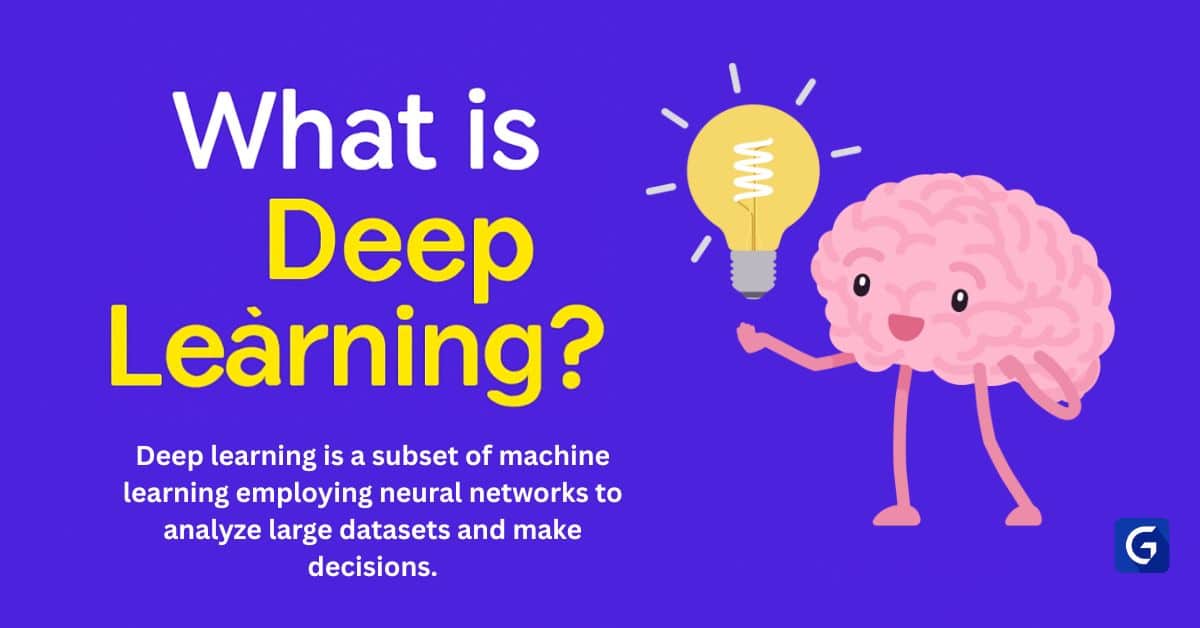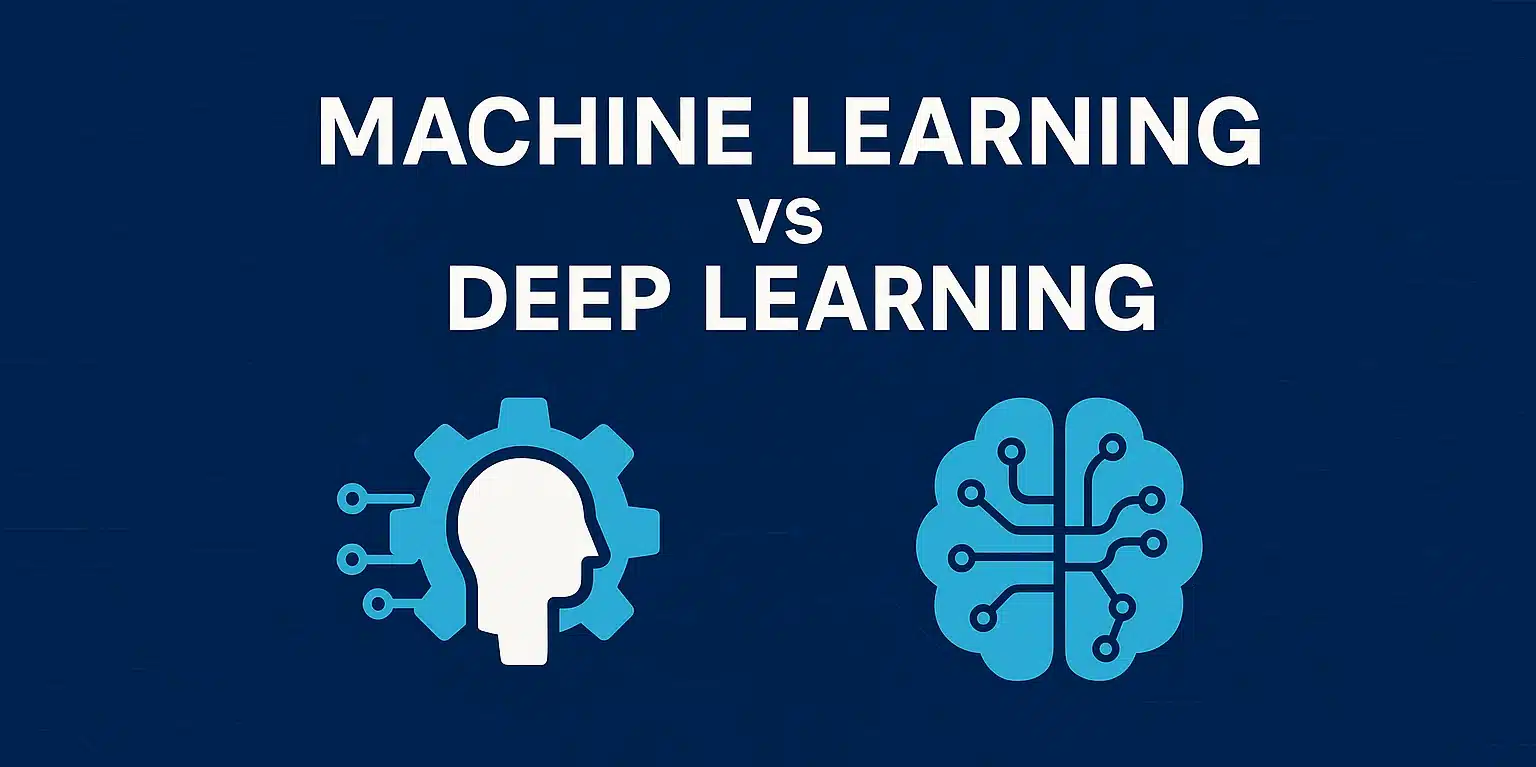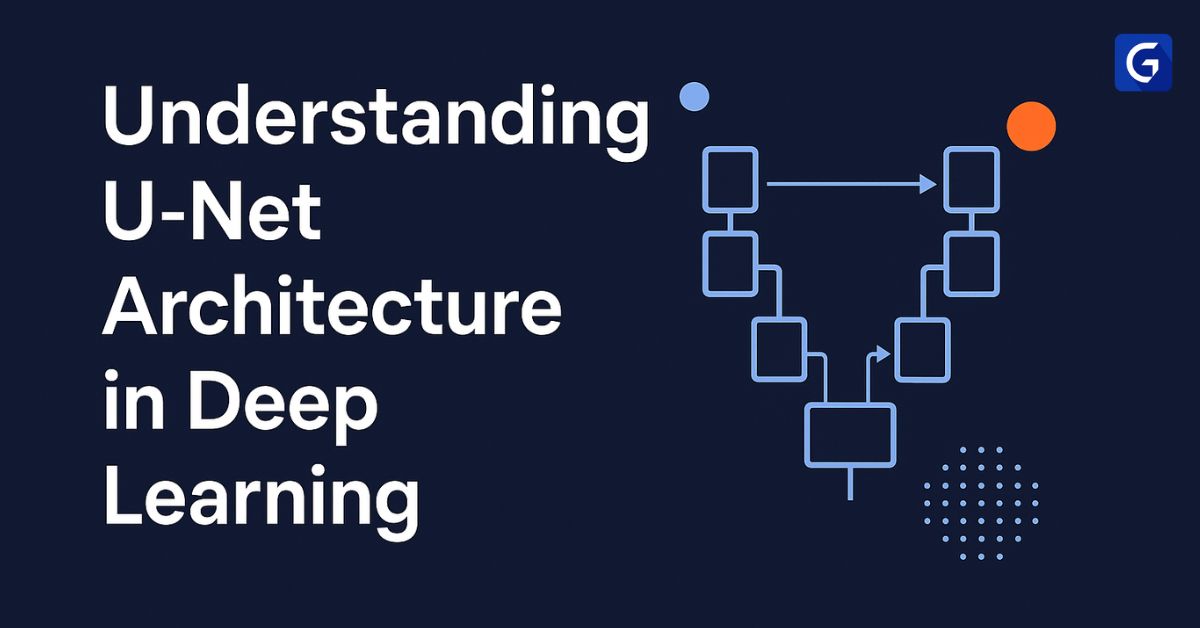Have you ever wondered how Netflix detects your future viewing choices or why your phone allows access with facial recognition?
That’s deep learning in action. Deep learning replicates brain functions to generate performance that surpasses that of the human brain, achieving speeds that astound users with remarkable accuracy.
What is Deep Learning?
Deep learning is a specialised subfield of machine learning that falls within the broader field of artificial intelligence (AI). The framework utilises artificial neural networks with numerous layers, which gives rise to the term “deep learning” for processing complex patterns in data.
The design of these networks mirrors brain operations, allowing machines to gain knowledge from extensive datasets without requiring excessive human oversight.
Key Characteristics of Deep Learning
- Multilayered Neural Networks: The deep learning format comprises neural networks with multiple layers that enable hierarchical data processing to detect complex data structures and abstract representations.
- Automatic Feature Extraction: The system automatically extracts features directly from raw data, as deep learning models diverge from traditional machine learning approaches.
- Handling Unstructured Data: The capability of deep learning to handle unstructured data, including images, audio, and text, is particularly well-suited for applications in vision and natural language processing.
- High Data and Computational Requirements: Training a deep learning model is a significant undertaking. It requires massive datasets and substantial computational resources, including GPUS or TPUS, for faster data processing.
Understanding these requirements is crucial for anyone venturing into the world of deep learning, as it underscores the importance of having the right tools for the job.
Also Read: Structured and Unstructured Data
Types of Deep Learning
1. Supervised Learning
Supervised learning within deep learning requires trained models to process datasets with labelled data, serving a wide range of tasks that encompass image classification, fraud detection, and sentiment analysis. The model performs adjustments by assessing its predictions against correct answers.
The free Supervised Machine Learning Course from Great Learning offers practical instruction on loss functions and overfitting, as well as model evaluation basics, which serve as essential building blocks for novel structured data modellers.
2. Unsupervised Learning
Using unsupervised learning, deep models discover hidden patterns within unlabeled evaluation datasets, enabling practical applications such as customer grouping and anomaly detection.
The methods of dimensionality reduction and clustering predominantly rely on this approach to deliver practical clustering algorithms, such as K-Means and Principal Component Analysis (PCA).
3. Semi-Supervised Learning
The technique of semi-supervised learning utilises smaller amounts of labelled data alongside larger sets of unlabeled information to enhance model efficiency in situations where labelling is expensive.
4. Reinforcement Learning
Through trial-and-error experimentation, models learn to optimise environments by interacting with them in the context of reinforcement learning. Understanding the foundation of neural network structures is essential before moving on to dynamic learning methods.
How Does Deep Learning Work? (Step-by-Step)
1. Learning from Examples
The computational methodology known as deep learning utilises simulated neural networks to learn data patterns through machine processing techniques which mimic human brain operation.
A succession of interconnected neurons forms neural networks that use processed information to make decisions based on available examples. Data sharing at a high level helps the network recognise more processes in its operation.
- Artificial neural networks model brain neural structures to produce deep learning networks.
- Every example of data input strengthens the network until it develops superior pattern recognition capabilities.
- These networks learn through continuous adjustment of internal parameters, which work to reduce errors.
2. Layers of Abstraction
A deep learning model applies stacked multiple layers which successively transfer and discover abstract data features within input data. The model achieves understanding of intricate patterns through sequential data breakdown that happens across multiple layers.
- Input Layer- The primary stage receives raw data, including images and text records. The system takes the data as input without any specific processing while receiving it.
- Hidden Layers- These layers perform complex computations. The models detect successively abstract elements as they progress through each successive hidden layer. The first hidden layer detects image edges before more advanced hidden layers identify objects, along with faces.
- Output Layer- At the end of the process, the predictive outcome or classification emerges from the model, such as categorising images as cat pictures or dog pictures.
3. Passing Data Forward (Forward Propagation)
Data moving through the network pursues a forward sequence from the first layer to the last layer through forward propagation. The neural network distributes data to each neuron, which applies weight measures before sending the information to the next layer. The network generates predictions based on the calculation that happens at each of its layers.
- The system processes data through the input layer before solving it through subsequent hidden layers, one after the other.
- A neuron adopts incoming data through weighted multiplication, followed by the application of the activation function to calculate its output values.
- Forward propagation continues until the data reaches the output layer to complete its end prediction.
4. Making Predictions
The model outputs a prediction at the end of the forward propagation process. The prediction shows initial inaccuracies because the model lacks appropriate weights to reach minimal error levels. The model learns better predictions through repetitive mistake identification during many training cycles.
- During the final stage, the model generates its outcome as potential category probabilities (for instance, e.g. image cat detection likelihood).
- There exist numerous inaccuracies in the network’s predictions since complete training has not occurred, and further adjustments to learning are necessary.
5. Learning from Mistakes (Backpropagation)
The network conducts learning through what is known as backpropagation, which allows it to adapt from mistakes. The network checks its forecast with actual results after they are made. The computed size of the difference represents the error metric. The network uses the generated error to update the weights of its neurons until a minimum error occurs.
- The predicted output compares with actual values through a loss function to produce the error measurement.
- Through the process of backpropagation, the error signal moves backwards to update network weights and biases, which minimise the error value.
- The minimisation techniques, including gradient descent, determine the optimal weighting adjustments to decrease error levels.
6. Repeating and Improving
Multiple repetitions of forward propagation with error calculation with backpropagation take place during many epochs. During each cycle, the model adjusts its weight parameters to enhance prediction accuracy. As the model continues its process, it becomes more efficient at detecting patterns within the data.
- Multiple forward and backwards passes occur while the model trains on grouped examples.
- Weight adjustments occur after each epoch, leading to an enhanced model capability for predictions.
- More data exposure causes the network to enhance its processing ability and refine how its internal parameters operate.
7. Generalisation
After receiving training, the deep learning model develops the capability to predict results for fresh data points that were not used during its training process. The training process succeeds when the model demonstrates generalised capabilities because this proves the model has identified essential patterns instead of simply memorising training inputs.
- The trained model demonstrates the ability to transfer acquired knowledge from existing data to upcoming information which has not appeared during training.
- The model demonstrates its conceptual understanding by succeeding with previously unidentified data points because it learned core patterns, not just raw examples from the training phase.
- Through appropriate training and validation protocols, the model can prevent overfitting, which produces reliable performance across new samples.
The comprehensive path of Deep Learning alongside Machine Learning deployment techniques can be easily learnt through Great Learning’s Program in Data Science and Machine Learning in Python course, which equips you with the world’s best knowledge and practical skills that help you to strengthen your understanding.
Popular Deep Learning Models
Deep learning models are AI algorithms inspired by the human brain, using neural networks to recognize patterns and make decisions from large datasets.
- Convolutional Neural Network (CNN)
- Architecture Type: Feedforward
- Purpose / Use Case: Feature extraction from images and spatial data
- Key Applications: Image classification, object detection, facial recognition
- Notable Characteristics: Uses convolutional layers to capture spatial hierarchies in data
- Recurrent Neural Network (RN)
- Architecture Type: Recurrent
- Purpose / Use Case: Sequence modeling, time-series prediction
- Key Applications: Language modeling, speech recognition, stock prediction
- Notable Characteristics: Maintains a hidden state, suitable for sequential input
- Long Short-Term Memory (LSTM)
- Architecture Type: Recurrent
- Purpose / Use Case: Handling long-term dependencies in sequence data
- Key Applications: Chatbots, machine translation, music generation
- Notable Characteristics: Solves the vanishing gradient problem in standard RNNs
- Gated Recurrent Unit (GRU)
- Architecture Type: Recurrent
- Purpose / Use Case: Similar to LSTM but with fewer parameters
- Key Applications: Voice assistants, sentiment analysis
- Notable Characteristics: Faster and simpler than LSTM, handles sequences well
- Generative Adversarial Network (GAN)
- Architecture Type: Generative
- Purpose / Use Case: Synthetic data generation
- Key Applications: Image generation, data augmentation, deepfake creation
- Notable Characteristics: Consists of a generator and discriminator network in competition
- Autoencoder
- Architecture Type: Unsupervised
- Purpose / Use Case: Data compression and noise removal
- Key Applications: Dimensionality reduction, anomaly detection
- Notable Characteristics: Learns to reconstruct input data, often used for feature learning
- Transformer
- Architecture Type: Attention-based
- Purpose / Use Case: Sequence modeling without recurrence
- Key Applications: NLP (e.g., BERT, GPT), translation, summarization
- Notable Characteristics: Uses self-attention to process input in parallel
- BERT (Bidirectional Encoder Representations from Transformers)
- Architecture Type: Transformer-based
- Purpose / Use Case: Language understanding and context capture
- Key Applications: Question answering, search engines, sentiment analysis
- Notable Characteristics: Pretrained on large corpora, fine-tuned for specific NLP tasks
- GPT (Generative Pre-trained Transformer)
- Architecture Type: Transformer-based
- Purpose / Use Case: Language generation
- Key Applications: Chatbots, creative writing, code generation
- Notable Characteristics: The autoregressive transformer model excels in text generation
- Deep Belief Network (DBN)
- Architecture Type: Hybrid (unsupervised + supervised)
- Purpose / Use Case: Layer-wise pretraining and feature learning
- Key Applications: Image recognition, speech processing
- Notable Characteristics: Stacked Restricted Boltzmann Machines (RBMs)
- ResNet (Residual Network)
- Architecture Type: CNN Variant
- Purpose / Use Case: Training deeper networks without degradation
- Key Applications: Image recognition, object detection
- Notable Characteristics: Introduces skip connections to combat vanishing gradients
- VGGNet
- Architecture Type: CNN Variant
- Purpose / Use Case: Deep but simple convolutional model
- Key Applications: Image classification, visual recognition
- Notable Characteristics: Uniform architecture using small 3×3 filters
- AlexNet
- Architecture Type: CNN
- Purpose / Use Case: First deep CNN to achieve a breakthrough in ImageNet
- Key Applications: Image classification
- Notable Characteristics: Introduced ReLU and dropout to improve training
- YOLO (You Only Look Once)
- Architecture Type: CNN-based
- Purpose / Use Case: Real-time object detection
- Key Applications: Autonomous driving, surveillance
- Notable Characteristics: Performs detection in a single forward pass
- U-Net
- Architecture Type: CNN-based
- Purpose / Use Case: Biomedical image segmentation
- Key Applications: Medical imaging, satellite image analysis
- Notable Characteristics: Symmetrical encoder-decoder structure with skip connections
Applications of Deep Learning
- Image and Speech Recognition
Deep learning, particularly through Convolutional Neural Networks (CNNs) and Recurrent Neural Networks (RNNs), powers modern image and speech recognition systems. Time-based programs, including facial ID access and voice assistants such as Alexa or Google Assistant, offer machines a precise understanding of audio and visual data.
- Natural Language Processing (NLP) and Translation
The technology of deep learning creates revolutionary methods through which machines process and create human speech. Through transformer models, including BERT and GPT, language-processing tools such as chatbots, sentiment analysis, and translation applications (like Google Translate) can understand text contextually, thereby improving the quality of human-machine dialogue.
- Autonomous Vehicles and Robotics
Self-driving cars, alongside intelligent robots, primarily utilise deep learning technology to detect their surroundings and respond accordingly. AI systems that combine CNNS with YOLO can identify pedestrians, signs, and obstacles, thereby ensuring safer navigation through the use of reinforcement learning for real-time decision-making.
- Fraud Detection, Medical Diagnosis, and Recommendation Systems
Deep learning processes enhance the protection of users and improve medical care, while also enhancing system interaction. Financial detection of fraudulent transactions is combined with healthcare functions that utilise medical data and images to identify diseases early. The technology of deep learning powers personal recommendation systems operated by Netflix, Amazon, and other platforms in e-commerce and streaming.
Also Read: Top Deep Learning Tools
Final Words
Deep learning drives the industrial revolution through more innovative machine capabilities, along with personalized experiences and cutting-edge innovations in sectors of healthcare, finance, and autonomous system development.
The increasing need for AI experts makes deep learning fundamental knowledge that shows greater value than before.
Great Learning’s Postgraduate Program in Artificial Intelligence and Machine Learning offers a comprehensive curriculum to equip professionals for top-tier AI positions through hands-on training in real-world applications.






